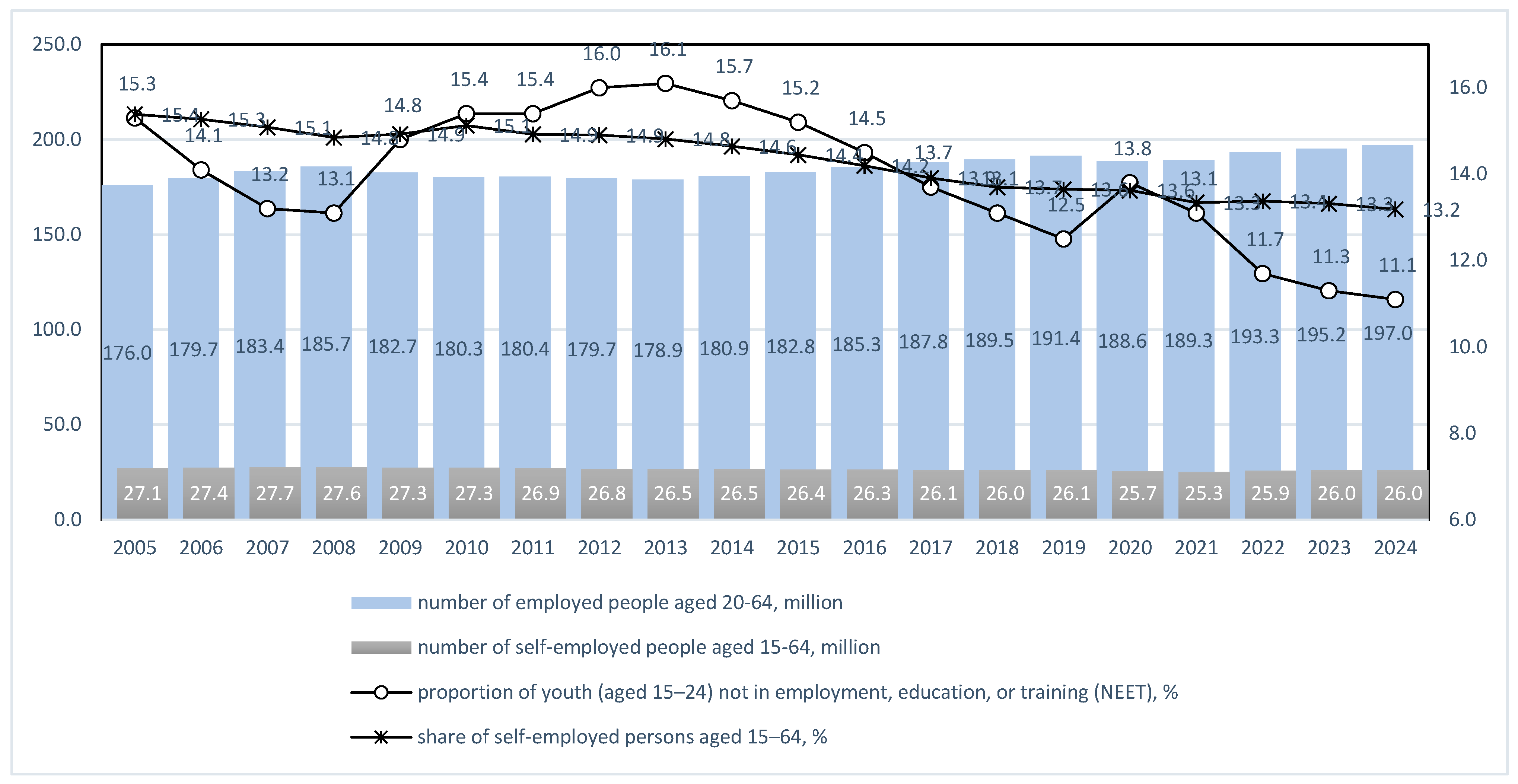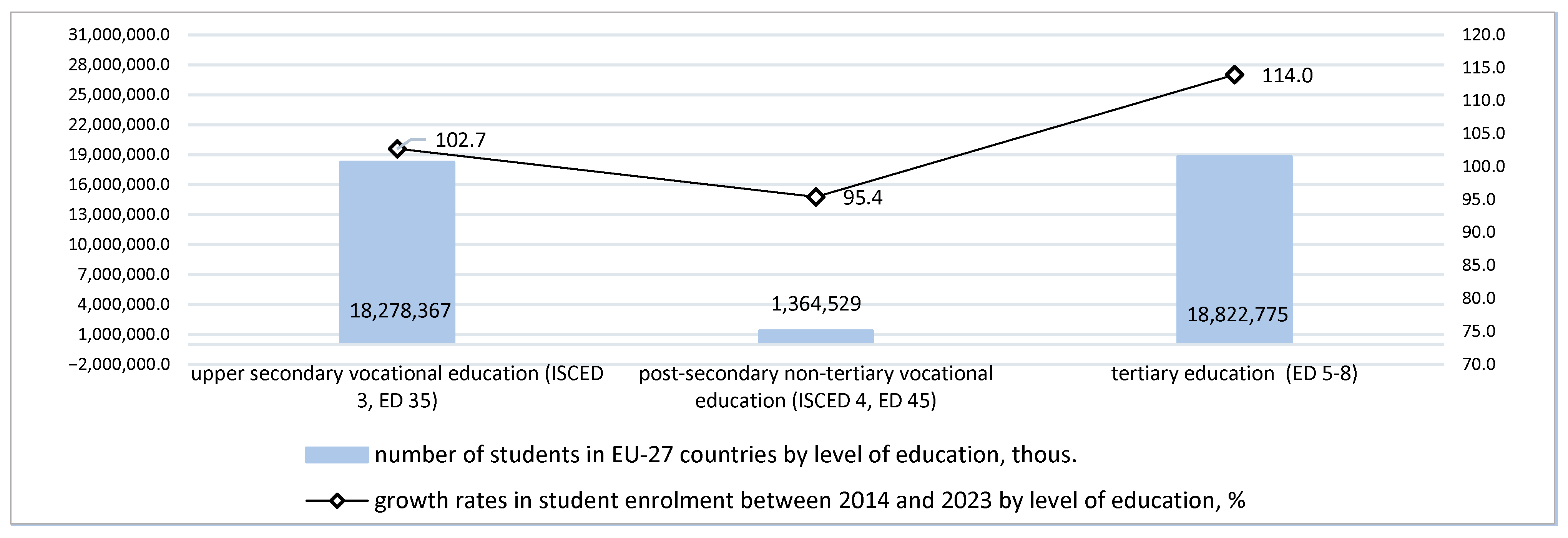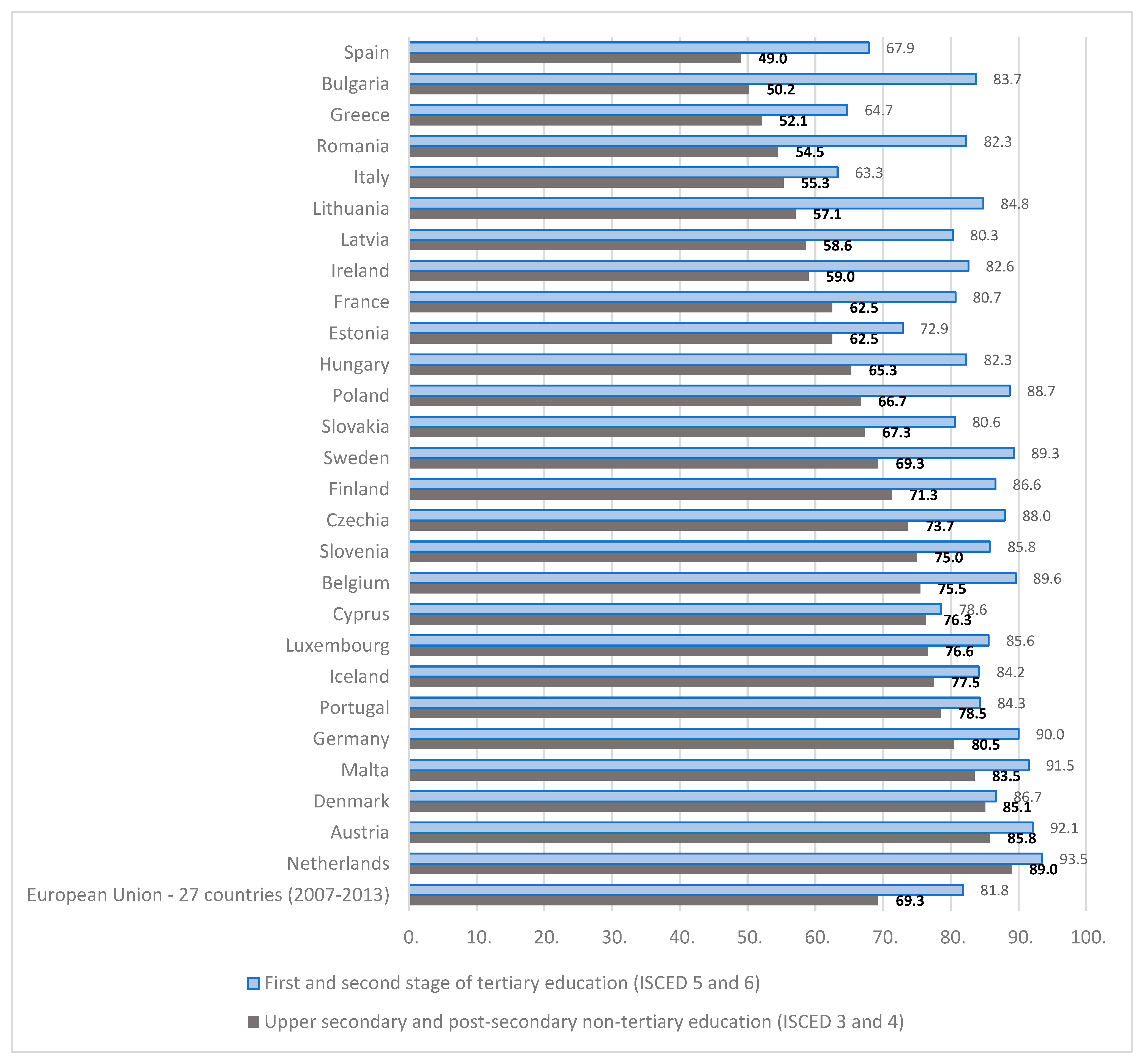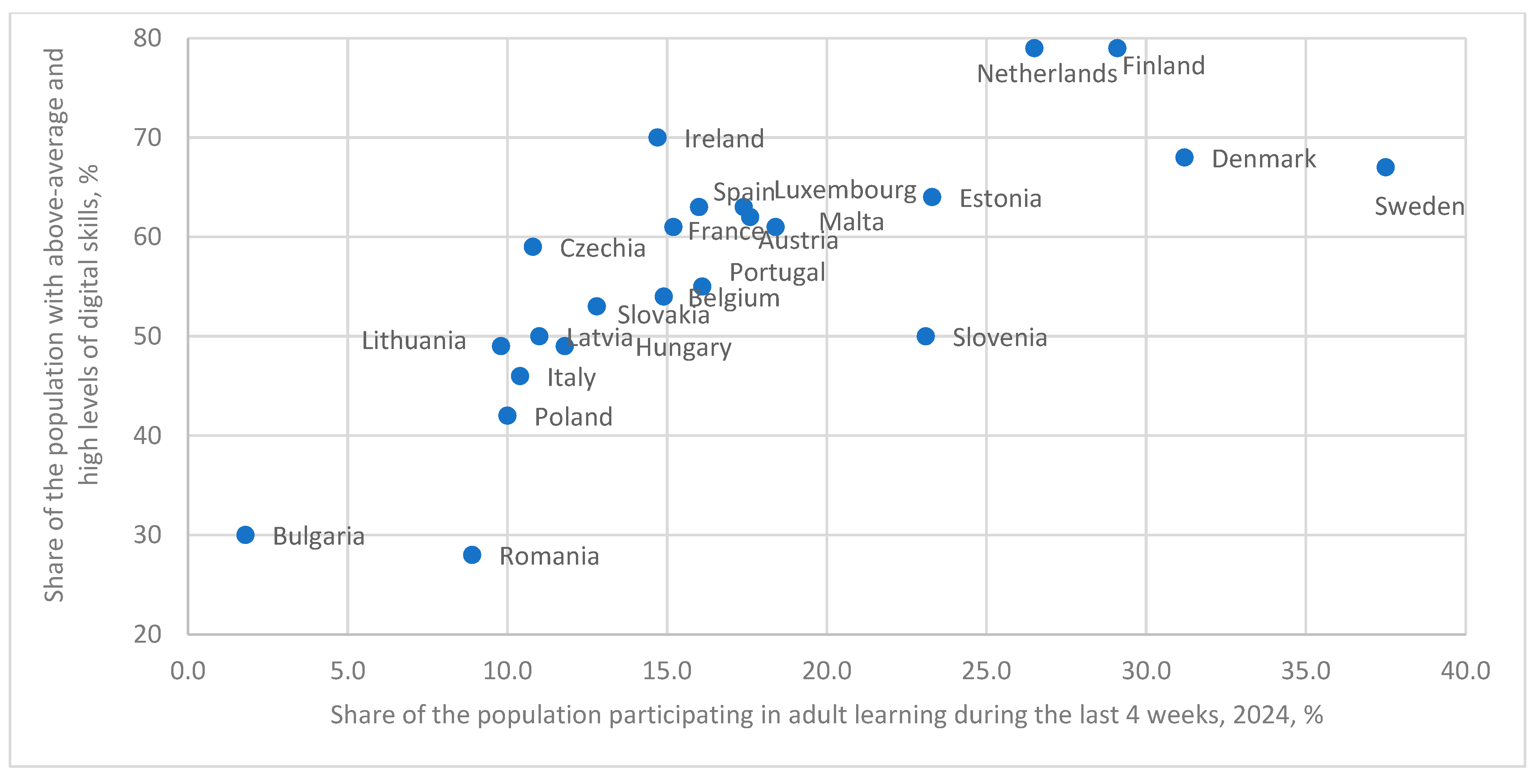Redesigning Sustainable Vocational Education Systems to Respond to Global Economic Trends and Labor Market Demands: Evidence from EU Countries on SDGs
Abstract
1. Introduction
- Strengthening youth employment through dual training. Evidence shows that Germany’s dual system, combining classroom instruction with paid apprenticeships, is highly effective in easing school-to-work transitions. In 2022, Germany had one of the lowest youth unemployment rates in the EU (7.6% vs. 13.1% EU average), with strong employer involvement supporting long-term employability and productivity (Cedefop, 2020) [18], (OECD, 2024) [7];
- Apprenticeship expansion and economic inclusion. Austria and Switzerland illustrate how inclusive apprenticeship policies can expand access for underrepresented groups, such as migrants and disadvantaged youth. Austria’s targeted VET funding has strengthened social cohesion and youth employment, directly supporting SDGs 4.5 and 8.3 (European Commission, 2021) [19];
- Skills anticipation and lifelong learning for productivity. Finland’s 2018 VET reform introduced individualized learning paths and modular curricula, combined with skills-forecasting tools, to enhance adaptability. These measures improved labor market integration and productivity, aligning with SDGs 4.3 and 8.2 (Cedefop, 2023) [20];
- Digitalization and economic modernization through VET. Estonia has prioritized digital transformation in VET by integrating e-learning platforms, AI-based career guidance, and digital certification. These initiatives prepare the workforce for Industry 4.0, boosting productivity and employability (Musset, 2019 [21], OECD, 2020 [22]);
- Green and digital competence integration in VET. Spain’s 2021–2025 VET Modernisation Plan embeds green and digital skills into curricula and expands micro-credentialing. This approach supports resilience, adaptability, and ecological transition, reinforcing SDG 8.4 (Jiménez et al., 2022) [23];
- work-based learning and upskilling strategies. The Netherlands emphasizes flexible learning and competency-based assessment in its “MBO” system, fostering continuous upskilling and regional labor market partnerships. These measures correlate with high employment rates of VET graduates and stronger workforce productivity, advancing SDGs 8.5, 8.6, and 10.3 (Cedefop, 2023) [24].
2. Materials and Methods
- Employment and self-employment rates by education level (especially ISCED 3–4);
- Share of youth not in employment, education, or training (NEET);
- Youth unemployment rate (ages 15–24);
- Growth dynamics in VET enrolment and graduation rates;
- Employment rates of VET graduates within three years post-graduation;
- Level of digital skills and adult participation in lifelong learning.
- Adoption of dual education models;
- Digital platforms and online learning formats;
- Integration of green skills and emerging professions;
- Adult learning participation rates;
- International mobility and institutional partnerships in VET.
3. Results
- Upper secondary vocational education (ISCED 3, ED 35). This level of education follows lower secondary education and is typically undertaken between the ages of 16 and 19. It focuses on practical training for specific occupations. In Germany, such education is delivered through Berufsschule, Fachschule, or duale Ausbildung; in France, through Lycée professionnel, CAP, or BEP; in Italy, through Istituto Professionale; in the Netherlands, through MBO level 3–4; and in Poland, through Technikum or szkoła branżowa II stopnia. The duration varies by country, generally ranging from 2 to 5 years. These programs usually lead to both an upper secondary school diploma and a vocational qualification. In many cases, practical training components are included, such as internships (e.g., in Spain) or in-company training (e.g., in Germany).
- Post-secondary non-tertiary vocational education (ISCED 4, ED 45). This level follows upper secondary vocational education (ISCED 3, ED 35) and is designed to deepen professional qualifications or retrain in a specific field. In France, such education is provided in Brevet de Technicien Supérieur (BTS) programs; in Germany, in Meisterschule or Fachschule; in Austria, in Kolleg institutions; and in Poland, through szkoła policealna.
4. Discussion
5. Conclusions
Author Contributions
Funding
Institutional Review Board Statement
Informed Consent Statement
Data Availability Statement
Conflicts of Interest
References
- European Commission Luxembourg, Publications Office of the European Union. Vocational Education and Training: Skills for Today and for the Future. 2022. Available online: https://op.europa.eu/webpub/empl/VET-skills-for-today-and-future/pdf/KE0621179ENN.pdf (accessed on 17 July 2025).
- The Union of Skills: Communication From the Commission to The European Parliament, The European Council, The Council, The European Economic and Social Committee and The Committee of The Regions. Brussels, 5.3.2025 COM(2025) 90 Final. Available online: https://commission.europa.eu/topics/eu-competitiveness/union-skills_en (accessed on 24 August 2025).
- Bieszk-Stolorz, B.; Dmytrów, K. Decent Work and Economic Growth in EU Countries: Static and Dynamic Analyses of Sustainable Development Goal 8. Sustainability 2023, 15, 13327. [Google Scholar] [CrossRef]
- European Commission Luxembourg, Publications Office of the European Union. Education and Training Monitor 2024: Comparative Report. 2025. Available online: https://www.cedefop.europa.eu/files/education_and_training_monitor_2024.pdf (accessed on 20 August 2025).
- Sethi, A.; Jangir, K.; Toshniwal, R.; Vaidya, R. Role of Vocational Training Effectiveness and Employment Outcomes in Sustainable Quality Education. In Proceedings of the 2nd International Conference on Emerging Technologies and Sustainable Business Practices-2024 (ICETSBP 2024), Mohali, India, 28–29 June 2024. [Google Scholar] [CrossRef]
- Building Pathways to Sustainable Growth: Strengthening TVET and Productive Sector Linkages in Africa; International Labour Office and African Development Bank: Geneva, Switzerland, 2023; Available online: https://www.ilo.org/sites/default/files/wcmsp5/groups/public/%40africa/%40ro-abidjan/%40sro-cairo/documents/publication/wcms_881406.pdf (accessed on 20 August 2025).
- Challenging Social Inequality Through Career Guidance. Insights from International Data and Practice; OECD Publishing: Paris, France, 2024; Available online: https://www.oecd.org/content/dam/oecd/en/publications/reports/2024/02/challenging-social-inequality-through-career-guidance_be87ce97/619667e2-en.pdf (accessed on 19 July 2025).
- Hanushek, E.A.; Woessmann, L.; Schwerdt, G.; Zhang, L. General Education, Vocational Education, and Labor-Market Outcomes over the Life-Cycle. J. Hum. Resour. 2017, 52, 48–87. [Google Scholar] [CrossRef]
- The Changing Nature of Work: World Development Report; World Bank: Washington, DC, USA, 2019; Available online: https://documents1.worldbank.org/curated/en/816281518818814423/pdf/2019-WDR-Report.pdf (accessed on 17 October 2025).
- Skills Policies for Resilience; OECD; Cedefop; European Commission; ETF; ILO; UNESCO: Paris, France, 2024; Available online: https://www.oecd.org/content/dam/oecd/en/topics/policy-issues/adult-skills-and-work/Skills_Policies_for_Resilience.pdf (accessed on 15 July 2025).
- UNESCO. Transforming Technical and Vocational Education and Training for Sustainable and Inclusive Growth: UNESCO Strategy 2022–2029. 2022. Available online: https://unevoc.unesco.org/pub/unesco_strategy_for_tvet_2022-2029.pdf (accessed on 17 October 2025).
- Hilal, R. The Invisible Contribution of TVET to SDGs–Palestine Case. Int. J. Vocat. Educ. Train. Res. 2022, 8, 60–68. [Google Scholar]
- Lee, H.; Hong, I. Quantifying the influence of vocational education and training with text embedding and similarity-based networks. PLoS ONE 2025, 20, e0329405. [Google Scholar] [CrossRef] [PubMed]
- Persson Thunqvist, D.; Gustavsson, M.; Halvarsson Lundqvist, A. The role of VET in a green transition of industry: A literature review. Int. J. Res. Vocat. Educ. Train. 2023, 10, 361–382. [Google Scholar] [CrossRef]
- Publications Office of the European Union; Cedefop. Digital Gap During COVID-19 for VET Lerners at Risk in Europe. 2020. Available online: https://www.cedefop.europa.eu/files/digital_gap_during_covid-19.pdf (accessed on 10 July 2025).
- Greinert, W.-D. Mass Vocational Education and Training in Europe: Classical Models of the 19th Century and Training in England, France and Germany During the First Half of the 20th. CEDEFOP Panorama Series, 2005. Available online: https://www.cedefop.europa.eu/files/5157_en.pdf (accessed on 12 August 2025). CEDEFOP Panorama Series.
- European Training Foundation; UNESCO-UNEVOC. Innovating Technical and Vocational Education and Training: A Framework for Institutions. 2020. Available online: https://unevoc.unesco.org/pub/innovating_tvet_framework.pdf (accessed on 8 July 2025).
- Vocational Education and Training in Germany: Short Description; Cedefop; Publications Office: Luxembourg, 2020; Available online: http://data.europa.eu/doi/10.2801/329932 (accessed on 17 October 2025).
- European Commission. Commission Staff Working Document: Putting into Practice the European Framework for Quality and Effective Apprenticeships–Implementation of the Council Recommendation by Member States. Brussels, 13.8.2021 SWD(2021) 230 Final. 2021. Available online: https://irshare.eu/wp-content/uploads/2024/06/EN-final-swd-efqea_1632054923.pdf (accessed on 8 August 2025).
- Cedefop. Finland: The Government Sets Objectives for Vocational Education and Training. ReferNet Finland. 2023. Available online: https://www.cedefop.europa.eu/en/news/finland-government-sets-objectives-vocational-education-and-training (accessed on 20 July 2025).
- Musset, P.; Field, S.; Mann, A.; Bergseng, B. Vocational Education and Training in Estonia, OECD Reviews of Vocational Education and Training; OECD Publishing: Paris, France, 2019. [Google Scholar] [CrossRef]
- OECD Publishing. Strengthening the Governance of Skills Systems: Lessons from Six OECD Countries, OECD Skills Studies; OECD Publishing: Paris, France, 2020. [Google Scholar] [CrossRef]
- Aranda Jiménez, J.R.; Campos-García, I.; De-Pablos-Heredero, C. Vocational continuing training in Spain: Contribution to the challenge of Industry 4.0 and structural unemployment. Intang. Cap. 2022, 18, 20–38. [Google Scholar] [CrossRef]
- Cedefop. The Future of Vocational Education and Training in Europe: Synthesis Report. Cedefop Reference Series; No 125; Publications Office: Luxembourg, 2023; Available online: http://data.europa.eu/doi/10.2801/08824 (accessed on 20 August 2025).
- Eurostat. Available online: https://ec.europa.eu/eurostat (accessed on 20 August 2025).
- Students Enrolled in Tertiary Education by Education Level, Programme Orientation, Sex, Type of Institution and Intensity of Participation. Eurostat. Available online: https://ec.europa.eu/eurostat/databrowser/view/educ_uoe_enrt01/default/table?lang=en&category=educ.educ_part.educ_uoe_enr.educ_uoe_enrt (accessed on 21 June 2025).
- Eurostat. Students Enrolled in Upper Secondary Education by Programme Orientation and Sex. Available online: https://ec.europa.eu/eurostat/databrowser/view/educ_uoe_enrs05/default/table?lang=en&category=educ.educ_part.educ_uoe_enr.educ_uoe_enrs (accessed on 21 June 2025).
- OECD. Education at a Glance 2023: OECD Indicators; OECD Publishing: Paris, France, 2023. [Google Scholar] [CrossRef]
- Cedefop. Vocational Education and Training Policy Briefs 2023–Germany. Cedefop Monitoring and Analysis of Vocational Education and Training Policies. 2024. Available online: http://data.europa.eu/doi/10.2801/035346 (accessed on 20 August 2025).
- Huismann, A.; Hippach-Schneider, U. Vocational Education and Training in Europe–Germany: System Description. In Vocational Education and Training in Europe: VET; Cedefop, & ReferNet: Hove, UK, 2024; Available online: https://www.researchgate.net/publication/384684803_Vocational_Education_and_Training_in_Europe_-_system_description_Germany_2023 (accessed on 22 May 2025).
- Education Policy Outlook in Greece. OECD Education Policy Perspectives, No17. 2020. Available online: www.oecd.org/en/publications/education-policy-outlook-in-greece_f10b95cf-en.html (accessed on 19 July 2025).
- Liu, H.; Paramalingam, M. Aligning Vocational Education with Emerging Industry Trend. J. Neonatal Surg. 2025, 14, 360–369. [Google Scholar] [CrossRef]
- Kuczera, M. Vocational Education and Training (VET) and the Green Transition: Insights from Labour Market DATA; Social, Employment and Migration Working Papers No. 327; OECD: Paris, France, 2025. [Google Scholar] [CrossRef]
- European Commission. Digital Economy and Society Index (DESI). 2022. Available online: https://digital-strategy.ec.europa.eu/en/library/digital-economy-and-society-index-desi-2022 (accessed on 2 July 2025).
- Klingberg, L. EU Looks to Plug STEM Skills Gap. Science|Business 2025. Available online: https://sciencebusiness.net/news/careers/eu-looks-plug-stem-skills-gap (accessed on 19 July 2025).
- Key Indicators on VET. Cedefop. Available online: https://www.cedefop.europa.eu/en/tools/key-indicators-on-vet/indicators?year=recent#89 (accessed on 14 May 2025).
- European Commission. Vocational Education and Training Initiatives. 2023. Available online: https://education.ec.europa.eu/ru/education-levels/vocational-education-and-training/about-vocational-education-and-training?utm_source=chatgpt.com (accessed on 2 July 2025).
- Hu, J.; Huang, Z.; Li, J.; Xu, L.; Zou, Y. Real-Time Classroom Behavior Analysis for Enhanced Engineering Education: An AI-Assisted Approach. Int. J. Comput. Intell. Syst. 2024, 17, 167. [Google Scholar] [CrossRef]







| SDG Indicator | Description | Role of VET | Expected Outcomes of VET Development |
|---|---|---|---|
| SDG 4—Quality Education | |||
| 4.3 (Indicator 4.3.1) | Participation rate of youth and adults in formal and non-formal education and training in the previous 12 months, by sex | VET provides accessible pathways to lifelong learning and skills development | Increased participation in vocational and continuous learning programs |
| 4.4 (Indicator 4.4.1) | Proportion of youth and adults with information and communications technology (ICT) skills, by type of skill | VET integrates ICT, digital, and green skills into curricula | Improved digital readiness and green transition adaptability |
| 4.5 (Indicator 4.5.1) | Parity indices (female/male, rural/urban, bottom/top wealth quintile) for all education indicators | VET promotes inclusiveness through targeted programs for disadvantaged groups | Reduced gender, regional, and socioeconomic disparities in education and skills acquisition |
| 8.2 | Achieve higher levels of economic productivity | VET facilitates the acquisition of applied and technical competencies that enhance labor efficiency and foster innovation | Increased labor productivity and innovation capacity across economic sectors |
| 8.3 | Promote the formalization and growth of micro-, small-, and medium-sized enterprises (MSMEs) | VET equips a workforce prepared to meet the needs of small businesses, including the service sector and craft production | Greater formalization of employment relationships and strengthened youth entrepreneurship |
| SDG 8—Decent Work and Economic Growth | |||
| 8.5 (Indicator 8.5.2) | Ensure full and productive employment and decent work for all | VET provides pathways to employment without necessitating higher education and adapts training content to regional labor market demands | Improved employment outcomes among youth, women, and persons with disabilities |
| 8.6 (Indicator 8.6.1) | Substantially reduce the proportion of youth not in employment, education, or training (NEET) | VET serves as a critical alternative for individuals who do not pursue higher education | Reduced NEET rates and mitigation of risks associated with social exclusion |
| SDG 10—Reduced Inequalities | |||
| 10.2 (Indicator 10.2.1) | Proportion of people living below 50% of median income, by age, sex and disability status | VET enhances labor market inclusion of low-income and vulnerable groups | Increased income levels and social mobility among disadvantaged populations |
| 10.3 (Indicator 10.3.1) | Proportion of population reporting having personally felt discriminated against or harassed in the previous 12 months, on the basis of grounds prohibited by international human rights law | VET fosters equal opportunities and combats discrimination through inclusive education and certification practices | Lower incidence of perceived discrimination and stronger representation of vulnerable groups in skilled employment |
| Evidence Type | Indicators/Sources | Key Findings |
|---|---|---|
| Quantitative | - 19.6 million enrolled in VET (2023) [27,28] - 38% of upper-secondary students in VET (2022, Eurostat) - Stable number of self-employed with VET vs. 1.5× growth among tertiary-educated (2005–2024) [27] | VET enrolment remains stable or declining in many EU countries; self-employment among VET graduates shows little growth compared to tertiary graduates. |
| Qualitative | - Societal undervaluing of VET [29] - School systems focused on university prep [29] - Case examples: Germany, Austria, NL with strong dual systems [30] | Cultural perceptions and policy design limit VET’s impact in many countries; however, where dual systems exist, VET leads to lower youth unemployment and better workforce readiness. |
| Synthesis | Comparative integration of data and case evidence | The hypothesis is only partially supported: VET’s contribution to employment/self-employment is conditional, depending on institutional models and labor market alignment. |
| Evidence Type | Indicators/Sources | Key Findings |
|---|---|---|
| Quantitative | - EU average employment rates: HE graduates 81.8% vs. VET graduates 69.3% (Eurostat 2024) [25] - Employment rates in dual system countries: Germany 80.5%, Austria 85.8%, Denmark 85.1% [25] - Youth unemployment lowest in high dual-system countries (Quartile IV) vs. highest in countries with weak dual VET (Quartiles I–II) [30] | Overall EU data shows VET graduates below HE peers in employment, but dual system countries outperform both the EU average and many HE graduates. |
| Qualitative | - Weak employer integration in Eastern Europe (Bulgaria, Romania) limits VET impact [31] - Cultural bias: academic degrees valued higher for career advancement [28] - Evidence from dual systems: internships + employer linkages facilitate smoother school-to-work transitions | Context matters: where VET is undervalued or disconnected from employers, outcomes are weaker; where dual systems exist, outcomes are significantly better. |
| Synthesis | Comparative integration of statistics and case studies | H2 is only partially supported: VET graduates do not systematically outperform HE graduates, but in countries with strong dual systems, VET significantly reduces youth unemployment and ensures high employability. |
| Share of Graduates, 2015 (%) | Share of Graduates, 2022 (%) | Change 2015–2022 | ||||
|---|---|---|---|---|---|---|
| Field of Education | Share of Graduates, 2015 (%) Upper Secondary Vocational | Share of Graduates, 2015 (%) Post-Secondary Non-Tertiary | Share of Graduates, 2022 (%) Upper Secondary Vocational | Share of Graduates, 2022 (%) Post-Secondary Non-Tertiary | Change 2015–2022 (%) Upper Secondary Vocational | Change 2015–2022 (%) Post-Secondary Non-Tertiary |
| General Programs | 4.35 | 4.45 | 0.10 | 0.02 | −4.25 | −4.43 |
| Services | ||||||
| Education | 1.30 | 2.78 | 1.31 | 2.66 | 0.01 | −0.12 |
| Arts and Humanities | 5.59 | 5.66 | 6.13 | 6.96 | 0.54 | 1.30 |
| Social Sciences, Journalism and Information | 2.11 | 1.18 | 1.69 | 0.79 | −0.42 | −0.39 |
| Business, Administration and Law | 15.65 | 18.52 | 14.67 | 13.36 | −0.98 | −5.16 |
| Natural Sciences, Mathematics and Statistics | 0.20 | 0.86 | 0.56 | 1.01 | 0.36 | 0.15 |
| ICT (Information and Communication Technologies) | 4.12 | 2.76 | 5.00 | 3.77 | 0.88 | 1.01 |
| Health and Welfare | 9.58 | 17.55 | 12.00 | 20.14 | 2.42 | 2.59 |
| Services (Broad Level) | 18.84 | 17.71 | 19.32 | 18.42 | 0.48 | 0.71 |
| Production | ||||||
| Engineering, Manufacturing and Construction | 34.30 | 13.87 | 34.60 | 16.97 | 0.30 | 3.10 |
| Agriculture | 4.03 | 1.91 | 4.63 | 2.26 | 0.60 | 0.35 |
| Evidence Type | Indicators/Examples | Key Insight |
|---|---|---|
| H3: VET systems in EU countries are undergoing active transformation to adapt to the modern labor market demands amid global economic challenges | ||
| Quantitative | - Services sector ~70% vs. manufacturing 30% of EU economy (27) - Adult learning: 5.3% (2002) → 13.5% (2024). - STEM graduates in VET: 38.7% (2022), below EU 2030 target 45%. | Structural shifts toward services, digitalization and green transition confirmed by data. |
| Qualitative | - Denmark: climate-oriented VET schools (Rybners, Herningsholm). - Netherlands: circular economy curricula (2023–2030). - Digital platforms (Coursera, Udemy, EdX) reshaping delivery. | Transformation is evident, but pace uneven and weak in some regions. |
| Synthesis | Comparative integration of statistics and case studies | The evidence confirms H3: EU VET systems are transforming in response to global trends, though adaptation remains uneven across regions, with structural gaps in forecasting and employer alignment. |
| H4: The transformation of VET in the EU contributes to the achievement of SDG 8—Decent Work and Economic Growth | ||
| Quantitative | - Employment gains in IT, health, logistics, green economy. - Erasmus+ budget €26 bn, supporting 130,000 learners/year [38]. | Modernized VET contributes measurable labor market benefits. |
| Qualitative | - “Europe on the Move”: 12% mobility target by 2030. - Adult learning frameworks linked to resilience and equity. | VET transformation directly supports SDG 8 through employability, mobility, and inclusion. |
| Synthesis | Comparative integration of statistics and case studies | The hypothesis is confirmed: VET reforms enhance employability, mobility, and inclusion, strengthening labor market resilience and directly contributing to SDG 8. |
| H5: Innovative management models in VET (flexibility, digitalization, employer collaboration) enhance effectiveness and sustainable employment outcomes. | ||
| Quantitative | - Digital skills strongly correlated with lifelong learning (e.g., Sweden 37.5%, Finland 29.1%, vs. Greece 8.8%). - VR and simulation tools adopted in some institutions. | Data confirms effectiveness of flexible/digitalized approaches under strong governance. |
| Qualitative | - Effective governance enables blended learning, online courses, personalized pathways. - Weak institutions face resource shortages, poor STEM integration. | Hypothesis partially confirmed: management capacity is the decisive factor. |
| Synthesis | Comparative integration of statistics and case studies | H5 is partially supported: innovative management enhances VET effectiveness, but outcomes remain conditional on institutional capacity and governance quality. |
Disclaimer/Publisher’s Note: The statements, opinions and data contained in all publications are solely those of the individual author(s) and contributor(s) and not of MDPI and/or the editor(s). MDPI and/or the editor(s) disclaim responsibility for any injury to people or property resulting from any ideas, methods, instructions or products referred to in the content. |
© 2025 by the authors. Licensee MDPI, Basel, Switzerland. This article is an open access article distributed under the terms and conditions of the Creative Commons Attribution (CC BY) license (https://creativecommons.org/licenses/by/4.0/).
Share and Cite
Storonyanska, I.; Benovska, L.; Patytska, K.; Ivashko, O.; Chulipa, I. Redesigning Sustainable Vocational Education Systems to Respond to Global Economic Trends and Labor Market Demands: Evidence from EU Countries on SDGs. Sustainability 2025, 17, 9530. https://doi.org/10.3390/su17219530
Storonyanska I, Benovska L, Patytska K, Ivashko O, Chulipa I. Redesigning Sustainable Vocational Education Systems to Respond to Global Economic Trends and Labor Market Demands: Evidence from EU Countries on SDGs. Sustainability. 2025; 17(21):9530. https://doi.org/10.3390/su17219530
Chicago/Turabian StyleStoronyanska, Iryna, Lilia Benovska, Khrystyna Patytska, Olena Ivashko, and Ihor Chulipa. 2025. "Redesigning Sustainable Vocational Education Systems to Respond to Global Economic Trends and Labor Market Demands: Evidence from EU Countries on SDGs" Sustainability 17, no. 21: 9530. https://doi.org/10.3390/su17219530
APA StyleStoronyanska, I., Benovska, L., Patytska, K., Ivashko, O., & Chulipa, I. (2025). Redesigning Sustainable Vocational Education Systems to Respond to Global Economic Trends and Labor Market Demands: Evidence from EU Countries on SDGs. Sustainability, 17(21), 9530. https://doi.org/10.3390/su17219530







